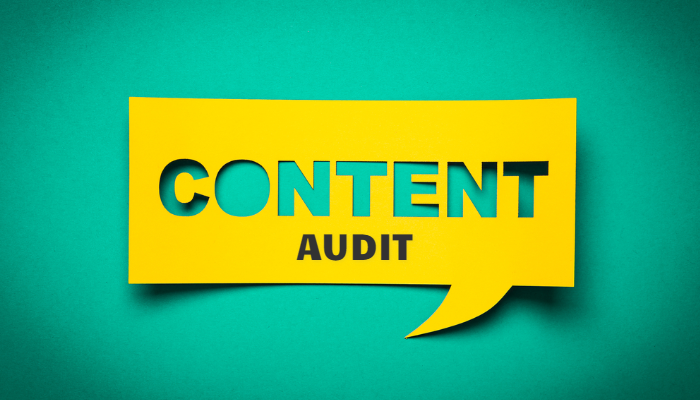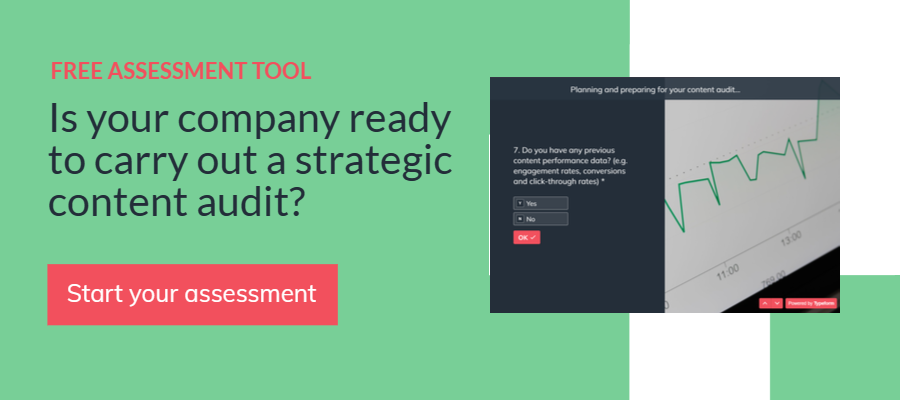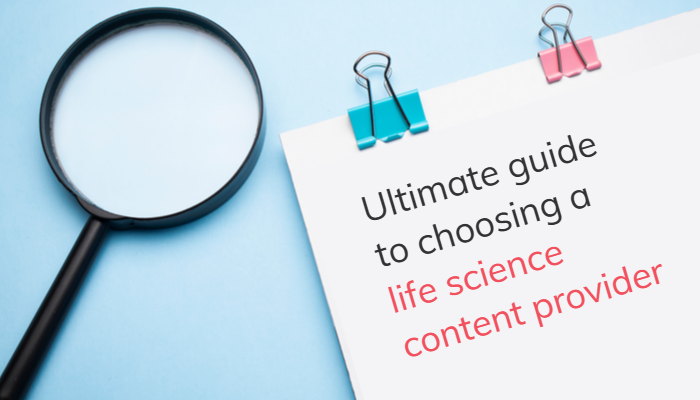As the world navigates through ongoing global economic uncertainty, life science marketers are grappling with challenges like never before. With budgets getting increasingly tighter, marketers are being tasked to do more with less and to make every pound, euro and dollar count. But how do you successfully maximise the value each of your marketing activities generates?
From our experience, the key to thriving in times of uncertainty lies in taking a step back and reassessing your life science marketing approach, and asking “how can I use the materials I already have?”, before investing in the development of new ones. Yet it’s imperative to answer this question strategically. There’s no point in repurposing content without a clear purpose – if you do, you risk investing more precious time and resources in ineffective marketing tactics.
One of the best ways to assess how you can utilise your existing assets is to perform a content audit. In this blog, we explore the steps involved in a strategic content audit and how marketers in the life sciences industry can leverage this process to drive success in their organisations. Whether you're looking to optimise your existing materials or create new content that aligns with your business and marketing objectives, a content audit completed by a content strategy specialist is a powerful tool that can help you achieve your marketing goals. For more content marketing tips, check out our recent blog on life science content marketing trends for 2023 to help you keep on top of the latest trends.
Once you reach the end of this blog post, you will have a better understanding of how to conduct a content audit that will identify how you can optimise your content marketing strategy and increase your return on marketing investment (ROMI). You’ll also find a useful tool, so you can assess whether you’re ready to complete your strategic content audit, or if there are other steps you need to complete first, to ensure you get the best results. By filling in the short questionnaire, you’ll have the option to receive a free recommendations report sharing advice based on your answers to help you get ready to perform a content audit.
What is a life science content audit?
Before we delve deeper into how to conduct your life science content audit, let’s first explore what a content audit actually is and why marketers might choose to conduct one.
In short, a content audit is the process of collecting and analysing your content assets, from landing pages to blogs, whitepapers, webinars, podcasts and everything in between. During the audit, you will assess whether your content:
- Performs well: think in terms of page views, bounce rate, lead generation etc.
- Is current: are there more current statistics that should be included?
- Is relevant: does it still address current customer challenges?
- Has been buyer persona optimised: is it tailored to your target audience?
- Supports the buyer’s journey: do you have the content you need for awareness, consideration and decision stages?
- Meets your current business needs: does it deliver against your marketing KPIs and business objectives?
- Is information rich: could it be repurposed into other content formats to increase its value?
But why go to the effort of analysing your content? Simply, a well-done content audit will allow you to identify:
- How you can quickly and easily improve/update your existing content
- Any gaps you currently have in your content offering
- What can be repurposed to create new budget-efficient content
- If any novel pieces need to be created
Ultimately, by taking the time to complete a content audit, you will have the insight you need to make your existing assets work harder, and know how you can create the most time- and cost-efficient content to make your marketing budget go further.
To ensure you get the most out of your strategic content audit, there are five steps we recommend following.
Step 1: Define your content goals and objectives
The all-important first step when performing a strategic content audit is to define your goals and objectives. This crucial activity sets the framework for the entire content audit process, ensuring it’s focused, relevant, and ultimately fruitful.
When defining your goals and objectives, though, you’ll need to keep a few key factors in mind. First, you’ll need to align your content goals and objectives with your overall business objectives and marketing goals. For example, if your business objective is to increase sales, and one of your marketing goals is to generate more leads, your content goals may revolve around producing content that will support lead generation or boost sales conversion rates.
It’s also essential to focus on your target customer’s experience and needs. After all, your content needs to resonate with your audience, helping address their challenges, and providing them with the information they need to make informed decisions about your products or services. By doing so, you will be able to effectively nurture your prospects along the buyer’s journey, to the point of sale.
Once you’ve defined the goals for your strategic content audit, you’re ready to move to the second step of the audit process.
Step 2: Identify your content inventory
The next step in performing a strategic content audit is to identify all the content assets you currently have. Don’t just look at the content on your website — include any trade media articles, scientific papers, posters, etc., too.
For the most successful content audit, be thorough and identify all your assets, including those that may have been forgotten or hidden away. Many life science organisations produce a large amount of content, some of which may be spread across different departments. Therefore, it's important to cast a wide net to capture all your content assets and ensure you have a complete inventory.
If you haven’t used content management tools to date, and your content is saved in various locations, this step can be time-consuming, and it can be tempting to take shortcuts. However, by collating as much content as possible, you will increase your chances of being able to update, reuse, and repurpose assets, which could result in saving time and money later in the process.
Step 3: Analyse your content inventory
Once you’ve identified your content inventory, the next step is to thoroughly analyse it to determine if and how it can be used going forward. This step is crucial as it enables you to create a content strategy that is based on insights and data, rather than assumptions or guesswork.
To start analysing your content inventory, you can use data analytics tools to generate quantitative data. These tools can help you measure the performance of your content, such as page views, time on page, and bounce rates. They can also help you understand how your content is being consumed, such as the devices and channels being used to access it. Insight such as this is invaluable when creating your content plan, as you can focus on producing content in the formats you know your target audience will most engage with.
Once your quantitative data is collected, it’s time to focus on your qualitative data. This is perhaps the hardest step of a content audit. At this stage, each piece of content needs to be reviewed to identify several aspects, including its key messages and whether it is fit for purpose. To ensure this is accurately done, we recommend an experienced content marketing strategist with a deep understanding of the life science industry performs this part of the audit. If the qualitative data produced here is inaccurate, the action plan you develop in Step 4 will likely be severely compromised.
To further enhance your analysis, you can also review any customer comments, feedback and inquiries related to each content piece. By doing so, you can more effectively identify areas where your content is falling short and needs improvement. Conversely, if there are pieces of content that are performing well, consider what lessons you can extract and apply to others.
Complete your analysis by identifying where you have content gaps. This involves pinpointing areas where you are lacking content or where your content needs improvement. For example, you might find that you have plenty of content for the awareness stage of the customer journey, but very little for the consideration or decision stages.
While identifying content gaps may sound simple, it’s imperative that whoever completes this stage is confident with assessing content against various strategic documents, including buyer personas, messaging pyramids and value propositions. Otherwise, you risk incorrectly identifying gaps and producing content you don’t actually need.
Overall, analysing your content inventory is a critical step in the content audit process. It will enable you to assess what's fit for purpose, what can be updated, and what can be repurposed. The result? The ability to develop a budget-efficient content strategy that is based on data, insights, and customer feedback.
Step 4: Develop your content strategy and action plan
Based on the insights gained from your content analysis, it's time to develop your content strategy and action plan. If you’re unsure of how to use the insights gained in Step 3 to generate your content strategy, download our eBook, “The Life Science Marketer’s Guide to Content Marketing” for a detailed overview. Alternatively, you can speak to our expert life science content strategists.
Once you have finalised your content strategy, we strongly recommend completing an action plan that maps the implementation of your content strategy against a timeline to ensure your activities stay on track. Your action plan should prioritise actions based on your goals and objectives, and the resources available. For example, if you have limited internal resources, you may want to focus on optimising existing content rather than creating new content.
When completing your action plan, it’s also important to identify whether you will need to engage with any third-party resources. For example, if you don’t have any writers in-house, even if you are repurposing content rather than creating pieces from scratch, you will likely need to work with a content creator.
Step 5: Implement your action plan
Now that you’ve developed an action plan, it's time to execute it. This phase is key as it’s where all your planning and preparation come together to produce tangible results.
One of the first things to do is to engage with all stakeholders involved. For example, have you agreed on a timeline with any third parties? Have you engaged with your subject matter experts to make sure they are available to review any technical content produced? To ensure success, it’s imperative that all involved understand what’s required of them and when.
Then, as you start executing activities, it’s important to track progress against your timelines to make sure you hit your deadlines and milestones. But don’t let your action plan be a static document. Instead, monitor your progress and processes to see if there are any lessons you can carry forward from one activity to the next to improve efficiency.
And it’s not only your action plan you should continually monitor and improve as necessary. Your content strategy should also be reviewed regularly. As campaigns go live, it’s essential to use data analytics tools to understand how your activities are performing. Tracking metrics such as engagement rates, conversions and click-through rates allows you to measure content performance. Using this data, you can identify what's working, what's not, and make informed decisions on how to adjust your content strategy to secure the best results.
How to prepare for performing a strategic content audit
Performing a strategic content audit is necessary for marketers in the life sciences sector to maintain and produce content that is relevant and effective. By setting specific objectives, assessing all content assets, evaluating performance, developing an action plan, and implementing changes, you can consistently improve your content assets and drive success in your organisation.
However, while content audits can be powerful tools, they require a lot of specialist skills and knowledge to do well. The best, and most valuable audits, are those completed by content strategists who have experience in analysing content in this way. What's more, in the life sciences, a content strategist with a scientific background and industry knowledge will be able to more rigorously assess, identify gaps and develop a more effective strategy than general strategists. Therefore, if you do not have the internal expertise to complete a life science content audit, we recommend working with a specialist agency.
At BioStrata, we understand the importance of content audits in the life sciences industry, and are committed to helping our clients achieve their marketing goals through comprehensive content strategies. If you're looking for expert support in conducting a strategic content audit or developing a content strategy that aligns with your business objectives, BioStrata can help. Our team of experienced professionals has a deep understanding of the life sciences industry and can provide customised solutions to meet your specific needs. Explore our science writing and content creation services to learn more.
We have also developed a 10-step assessment tool to assist life science marketers in preparing to perform a content audit. By completing the series of questions, you can opt to receive a valuable recommendations report with suggestions on what steps you need to take prior to performing your own audit.




